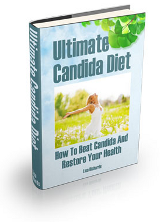In the most basic terms, yeast infections (also commonly referred to as Candida) are an overgrowth of the normal bacteria found in the body, within the GI tract, and in small numbers in the vagina. When the amount this bacteria grows out of balance, it may cause itching, soreness, and sometimes pain or burning. It is usually not serious and is easily treatable.
More specifically, numerous situations may cause Candida overgrowth. The following list contains some of these causes:
- poor diet choices
- low fiber intake
- high consumption of greasy or fried foods
- alcohol abuse
- recreational drug use
- changes in hormone levels during the week before menstruation
- high estrogen levels during pregnancy
- taking antibiotics
- poor hygiene
A few much more serious causes include uncontrolled diabetes, HIV infection, and a compromised immune system resulting from the onset of an illness or poor lifestyle choices.
Treatment Options
A new downloadable book entitled “The Ultimate Candida Diet,” by Lisa Richards, provides a comprehensive plan for permanently eliminating problems with Candida overgrowth.
Lisa Richards is a professional medical researcher and well-known author who personally experienced problems with the regular re-occurrence of Candid. As you can imagine, when she researched her personal treatment options and then wrote the leading book on the topic, her plan is very thorough and effective.
Ms. Richards provides not only a book (three actually), but an abundant supply of supporting resources to quickly manage and then eliminate Candida overgrowth. The information is well worth the one-time-cost of $37.00 for anyone who suffers from yeast infections. This one-time cost for a lifetime cure is but a fraction of the cost of a single doctor visit.
Ms. Richards suggests an occasional yet thorough self-inspection along with dietary changes for permanent control. Expensive medical tests also easily identify Candida overgrowth but require a physical examination by a doctor.
Medical Testing for Yeast Infections
On a visit with your gynecologist or physician, complete honesty about what you are experiencing is necessary. Often, vaginal infections are embarrassing and hard to talk about, but push modesty aside when looking for relief. The doctor will perform an internal visual exam, take blood and stool samples, and discuss your sexual and medical history.
Your doctor will be able to tell if your infection is from the fungus Candida, or bacterial vaginitis or trichomoniasis, caused by a parasite. These later causes are much less likely.
The existence of the Candida fungus is normal, in balanced amounts. Sometimes however something may kill friendly bacteria. If this happens, natural balance is destroyed and the fungus grows out of control. This imbalance is often first evident in the intestines, mouth or vagina. Candidasis can affect both genders, but is more prevalent in women, especially when experiencing a change in hormone levels.
Since every patient may have unique symptoms and a degree of infection, medical tests will reveal detailed information about the level of imbalance. One of the most revealing tests is based on stool analysis and evaluation of parasites. A typical stool test will measure 25 different parameters to determine levels for micro flora in the intestines, bacteria cultures, parasite levels, and further measure any imbalances that may exist among test levels.
Dietary Changes for Yeast Infections
Your diet should be the first area of suspicion when experiencing symptoms of overgrowth. By making healthy diet changes, you also set the stage for treatment by prescription, if necessary, or any of a number of effective home remedies.
There is also the chance of Candida die-off. This is known as a Herxheimer reaction. It indicates that your treatment plan is working. Be aware however that symptoms may become worse briefly before getting better. This is normal and expected. Give each treatment phase time to work before becoming concerned.
A few More Tips
Avoid sugary carbohydrates and load up on lean protein. Eat plenty of fiber, including perhaps crunchy fruits and vegetables such as apples, carrots and broccoli. Drink plenty of water. These dietary changes will help starve the excess bacteria in the body that grows uncontrollably in a high sugar environment.
These tips are but a few options for a first response to symptoms. For a much more complete explanation, and an effective long-term cure:
